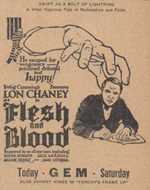
Au Secours!” is a frenchified film that is a collaboration of two of the most important silent film personalities of that European country: Herr Abel Gance und Herr Max Linder.
For Herr Gance to direct this two reel comedy was a kind of break after the contrarieties and problems during the filming of “La Roue” (1923) and before he began another complicated and colossal film project, “Napoléon” (1927), so, “Au Secours!” was an amusing trifle filmed between masterpieces, two film milestones in the silent film history. For Herr Linder, this film was his next to last film before he decided to leave this cruel world.
The original idea of the film was Max Linder’s who was a close friend of Herr Gance. It's not a very original idea for a comedy: Herr Max accepts a bet to spend an hour in a haunted house in order to win 1.000 francs, but there's a funny and surprising finale. In spite of “Au Secours!” being merely a divertimento, it has excellent examples of the superb Herr Gance’s cinematic achievements and techniques; for example, when Herr Max is clinging to a chandelier the image is distorted in different ways to give the illusion of vertigo. And there is also a fascinating travelling shot when Herr Max is entering the house, a shot that shows us the terrors awaiting the unknowing hero.
The comedy works perfectly well at the service of an efficient Herr Linder who will have to deal with a crowded haunted house full of strange devices and monsters, not to mention the great variety of animals that are in there ( hypos, hyenas, snakes, crocodiles, tigers… ), giving the impression that it is more of a zoo than a haunted house.
And now, if you'll allow me, I must temporarily take my leave because this German Count must ask for more daily help.
Herr Graf Ferdinand Von Galitzien
-/-
El filme “Au Secours!” es un filme afrancesado en el cual colaboraron dos de las más importantes celebridades con las cuales ha contribuido, para gloria e historia del cinematógrafo, dicho país europeo: Herr Abel Gance und Herr Max Linder.
Para Herr Gance dirigir este mediometraje cómico supuso una especie de descanso después de las contrariedades y problemas que tuvo que soportar durante el rodaje de “La Roue” (1923) nimiedades éstas en comparación con lo que posteriormente le estaba esperaba, el también complicado y colosal rodaje de “Napoleón” (1927), por lo que podemos decir que “Au Secours!” fue un divertido pasatiempo filmado entre dos obras maestras fundamentales de la historia muda y del cinematógrafo.
Para Herr Linder este fue su penúltimo filme antes de que decidiese dejar éste mundo cruel.
La idea original del filme fue obra de Herr Linder, amigo íntimo de Herr Gance, y aunque no se trata, ciertamente, de una idea demasiado original para una comedia ( Herr Max acepta una apuesta que consiste en pasar una hora en una casa encantada, si lo logra ganará la apreciable suma de 1.000 francos ) pero posee un divertido y sorprendente final.
Aunque “Au Secours!” sea un simple divertimento, en el filme se pueden encontrar excelentes ejemplos de los magníficos logros y la depurada técnica cinematográfica de Herr Gance, como por ejemplo, cuando Herr Max se halla colgado de una lámpara y la imagen se distorsiona en múltiples formas para dar sensación de vértigo al espectador, o el fascinante travelling cuando el protagonista se dispone a entrar en la casa encantada, transmitiendo al espectador la sensación de que un desconocido e inminente peligro le está esperando.
Como comedia funciona perfectamente y es idónea para el siempre eficiente Herr Linder, el cual tendrá que soportar una enorme variedad de extrañas trampas y monstruos, además de multitud de animales que deambulan por allí dentro ( hipopótamos, hienas, cocodrilos, serpientes, tigres... ), dando la impresión de antes que una casa encantada, eso parece más bien un zoológico.
Y ahora si me lo permiten les tengo que dejar momentáneamente, pues este Conde germánico tiene que solicitar más ayuda doméstica.
Herr Graf Ferdinand Von Galitzien







